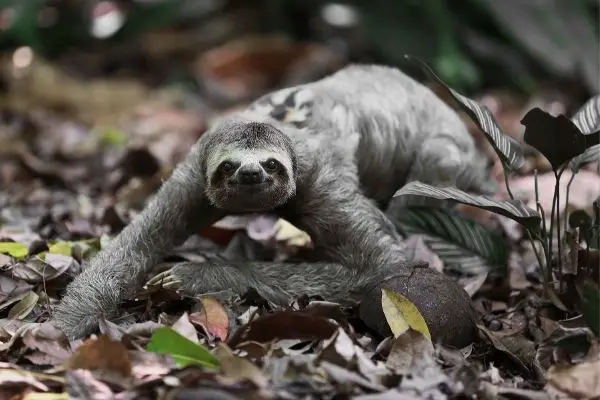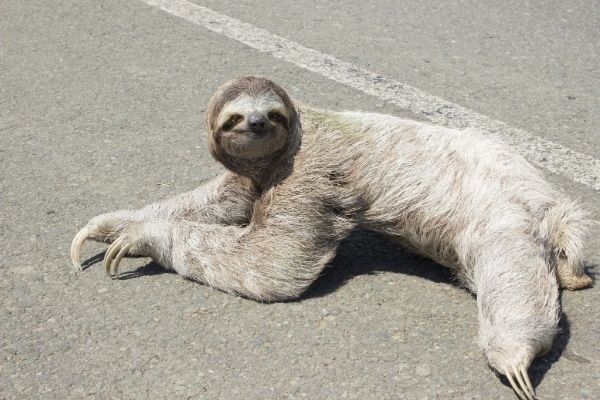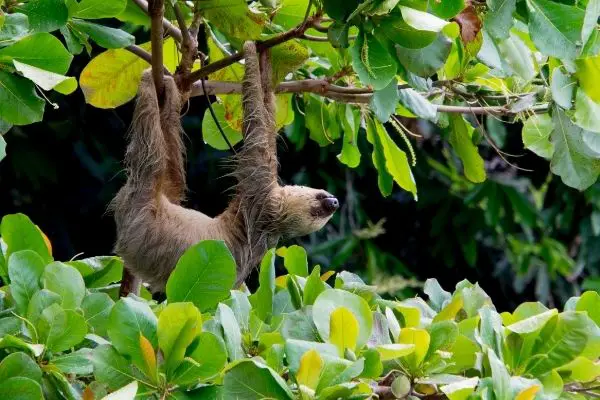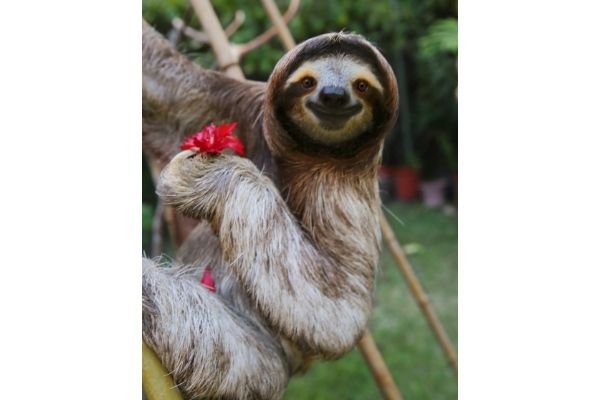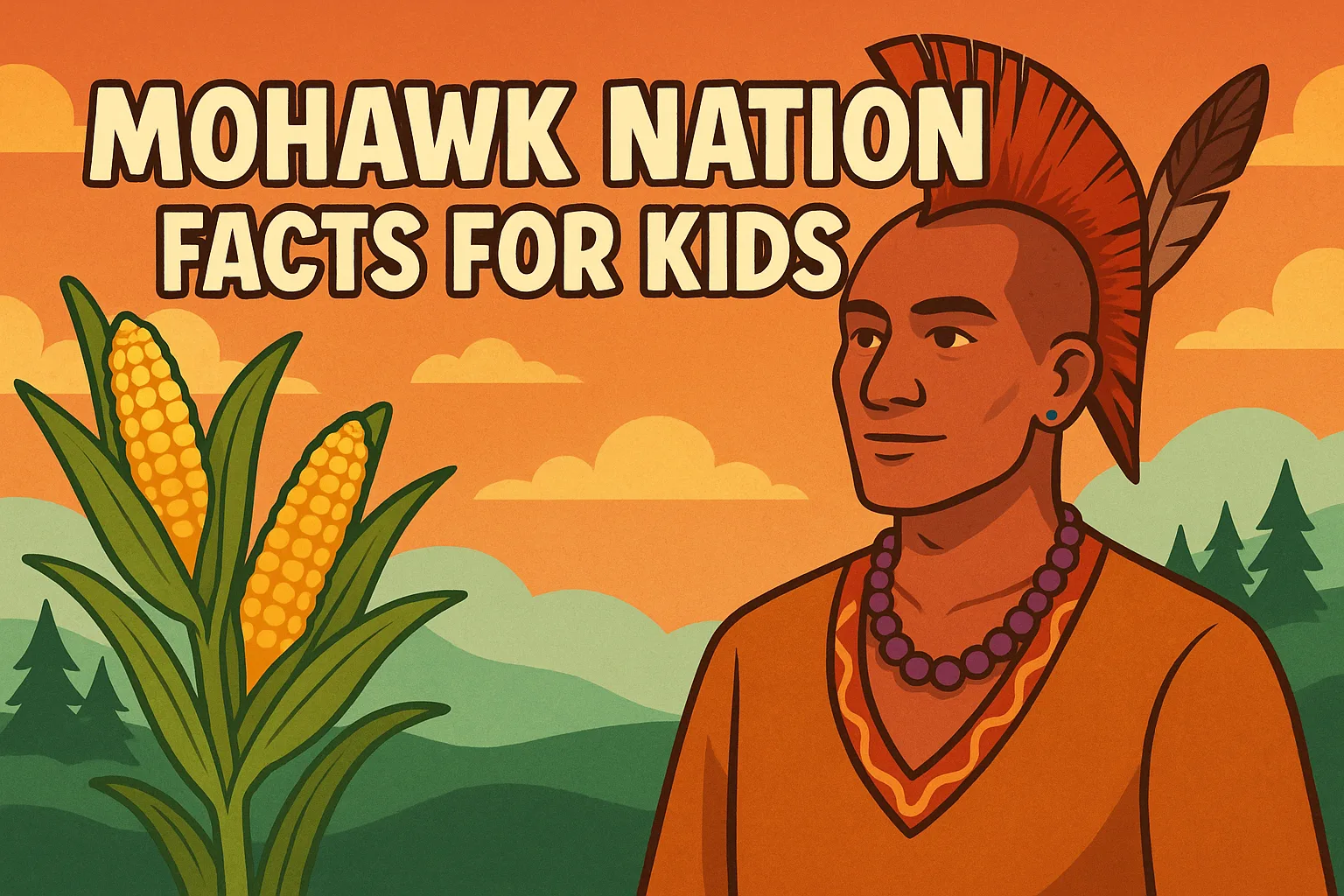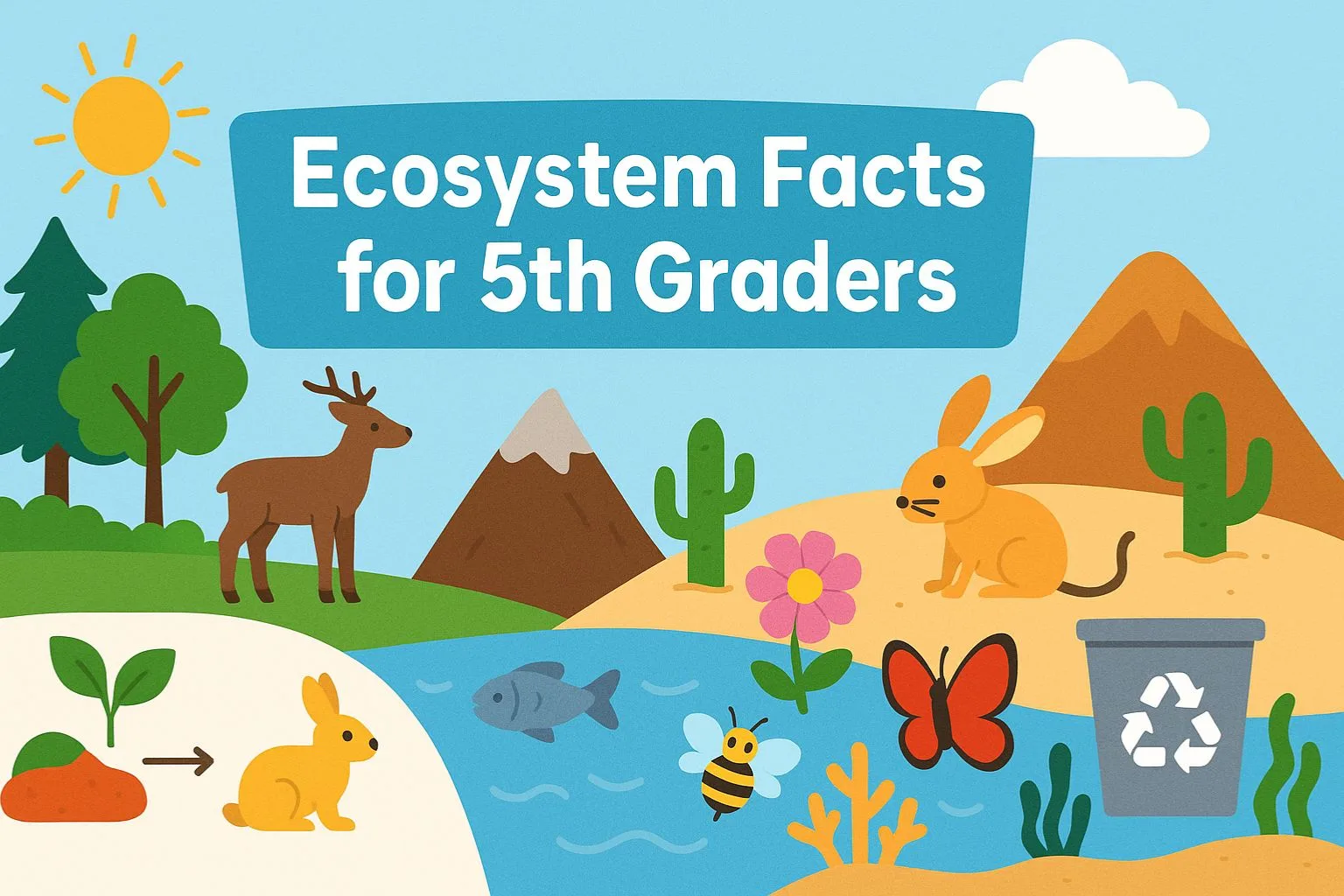The sloth is the slowest mammal in the whole world. It is so inactive that algae grow on its fur. We have listed down complete Sloth Facts for Kids that will help you in learning all about Sloths. You are going to learn about its scientific name & classification, evolution, appearance, physical features, physical abilities, diet, habitat, lifespan, reproduction, babies, behavior, adaptations, food chain, ecological role, endangerment, population, predators, and many other interesting facts about Sloths.
Sloth Facts For Kids
What Is A Sloth
Sloths are a group of tree-dwelling mammals well-known for their slowness. They are found in the tropical rain forests of Central and South America. They are named sloths because of their slow movements and extremely low metabolism.
They are herbivores and eat the leaves of Cecropia. They spend all of their time in trees hanging upside down in the canopy region of the forest and are almost helpless on the forest floor. There are two genera (commonly known as three-toed sloths and two-toed sloths) and six species of living sloths.

Scientific Name Of Sloth
The following are the scientific names of the six living sloth species:
- Choloepus didactylus (Linnaeus’s two-toed sloth)
- Choloepus hoffmanni (Hoffmann’s two-toed sloth)
- Bradypus pygmaeus (Pygmy three-toed sloth)
- Bradypus torquatus (Maned three-toed sloth)
- Bradypus tridactylus (Pale-throated three-toed sloth)
- Bradypus variegatus (Brown-throated three-toed sloth)
Scientific Classification Of Sloth
The following is the scientific classification or taxonomy of sloths:
| Domain | Eukaryota |
| Kingdom | Animalia |
| Phylum | Chordata |
| Subphylum | Vertebrata |
| Class | Mammalia |
| Suborder | Xenarthra |
| Order | Pilosa |
| Suborder | Folivora |
| Families (extant) |
|
| Genera |
|
| Species |
|
Evolution Of Sloths
It is believed that the superorder Xenarthra (to which sloths belong) evolved around 60 million years ago in South America. Most of the ancient sloths were terrestrial and some had an extremely huge size like that of an elephant, such as Megatherium.
The common ancestor of the living genera of the sloths dates back to about 28 million years ago. They then spread to the Caribbean Islands and North America. About 9 million years ago, the extinct genera Pliometanastes (of the extinct family Megalonychidae) and Thinobadistes (of the family extinct Mylodontidae) became able to colonize North America.
Around 3 million years ago, the latter development allowed members of the extinct families Megatheriidea and Nothrotheriidae to occupy North America. Their movement was part of the Great American Biotic Interchange event.
In addition, the Thalassocnus genus of the Nothrotheriidae family that inhabited the west coast of South America adopted a semi-aquatic lifestyle, and then perhaps a completely aquatic marine lifestyle. In the late Miocene, the Thalassocnus started to enter the coastal habitat in Peru and Chili.
What Does A Sloth Look Like
Appearance
Sloths have a smiling appearance due to the coloring of their faces. Their body size is about equal to a small dog and have a covering of long shaggy fur. They have small heads with tiny rounded ears, short thick tails, and sad-looking eyes.
All the species have long limbs. The forelimbs of the two-toed sloths have two digits and their hind limbs have three digits. While all the limbs of three-toed sloths have three digits.
Sloths have long hook-like claws which maybe 2.0 to 3.0 inches long. The fore-claws are longer than the hind claws.
Unlike other mammals (which have 7 cervical or neck vertebrae), two-toed sloths have 5 to 7, while three-toed sloths have 8 to 9 cervical vertebrae. Other mammals that do not have 7 cervical vertebrae are the manatees that have 6.
Three-toed sloths have a dental formula: 5 / 4-5. On each side of the upper jaw, they have 5 teeth, while only 4 teeth are on each side of the lower jaw. On each jaw, two of the teeth are incisors, however, they may be small or even absent on the upper jaw. The two-toed sloths have 4 to 5 sets of teeth. They lack incisors.
Three-toed sloths have exceptionally long arms, which are about 50% larger than their legs.
Color
Sloths usually have greyish-brown color fur. However, due to the growth of blue-green algae in their fur, it looks grey-green. Their nose and mouth are of dark-brown or black color. They have dark bands that run from their eyes, which make their eyes sad-looking.
Physical Features Of Sloths
Pygmy Three-toed Sloth
- Body Length (inches): 19 to 21
- Tail Length (inches): 1.8 to 2.4
- Weight (Kg): 2.5 to 3.5
Maned Sloth
- Body Length (inches): 22 to 28
- Tail Length (inches): About 2.0
- Weight (Kg): 4.0 to 7.5
Pale-Throated Sloth
- Body Length (inches): 18 to 22
- Tail Length (inches): 1.6 to 2.4
- Weight (Kg): 3.2 to 6.0
Brown-Throated Sloth
- Body Length (inches): 17 to 31
- Tail Length (inches): 1.0 to 3.5
- Weight (Kg): 2.2 to 6.3
Linnaeus’s two-toed sloth
- Body Length (inches): 18 to 34
- Tail Length (inches): 0.5 to 1.5
- Weight (Kg): 4.0 to 8.5
Hoffmann’s two-toed sloth
- Body Length (inches): 21 to 28
- Tail Length (inches): 0.6 to 1.2
- Weight (Kg): 2.1 to 9
Physical Abilities
Speed – How Slow Do Sloths Move
Sloths are very slow animals and are well-known for their slowness. In trees, their average movement speed is 13 feet (4 meters) per minute. However, they can move at a higher speed of 15 feet (4.5 meters) per minute in case of danger or stay away from predators. On the ground, they move at a higher speed of 9.8 feet (3 meters) per minute.
Jump
Sloths can not jump.
Climb
Sloths are excellent climbers as they are adapted to live in trees. They use their hook-like claws to climb trees. They climb at the speed of 6 to 8 feet (1.8 to 2.4 meters) per minute.
Swim
Sloths are excellent swimmers and paddle through the water using their long arms. They cross rivers between the islands through swimming. They can swim at the speed of 44 feet (13.5 meters) per minute.
What Do Sloths Eat
Diet In the Wild
All sloths eat the leaves of the trees belonging to the cecropia genus. The diet of two-toed sloths is diverse, as they eat leaves, fruits, insects, small lizards, and carrions. The diet of three-toed sloths is limited as they feed on the leaves, buds, and twigs of only a few trees. Sloths do not need to drink water as they obtain much moisture from their food. However, they are sometimes observed drinking water directly from the rivers.
Diet In Captivity
In captivity, sloths are fed with leaf eater food, such as Mazrui High Fiber Sticks and Marion Leaf Eater pallet food. At the San Diego Zoo, sloths are fed with biscuits that have low starch and high fiber, fresh fruits and vegetables, and a variety of fresh tree leaves.
List Of Food Items
- Leaves, buds, twigs, and fruits
- Insects, small lizards, and carrion (two-toed sloths)
How Much Sloth Eat Per Day
Sloths eat a very little amount of food per day because they have very low digestion and metabolic rate. The food they eat takes about a month to pass through their multi-chambered stomach and digestive tract. The estimated amount of food they eat every day is only 0.35 kg.
What Do Baby Sloth Eat
Baby sloths consume the milk of their mothers. They then start licking the lips of their mothers and learn what to eat.
Where Do Sloth Live – Sloth Habitat Facts
Natural Habitat
The natural habitat of sloths is the tropical rainforests and cloud forests of Central and South America. Sloths are arboreal and inhabit the canopy region of the forest and come to the ground only to urinate or defecate. The pygmy three-toed sloth is unique to all sloths species, as it inhabits only the red mangroves of Isla Escudo de Veraguas (a Caribbean Island).
Maned three-toed sloths currently inhabit only the Atlantic coast rain forest. They can also be found in secondary and semi-deciduous forests. Their habitat typically has hot and humid climates with at least 47 inches (120 cm) annual rainfall. Brown-throated three-toed sloths are found in many habitats, including the evergreen and dry forests. They usually live at the elevation of 1,200 meters (3,900 feet) from sea level.
Two-toed sloths are found in the ever-wet tropical rainforests where the climate remains humid and hot. They prefer to live in regions with a lot of vine growth, which allows them to easily move from tree to tree in the forest canopies.
Biome
Sloths inhabit various biomes, including tropical rainforests, secondary and semi-deciduous forests, and mangroves.
Habitat Range
The habitat range of pygmy three-toed sloths is very small and is only confined to the red mangroves of Isla Escudo de Veraguas. On the island, mangroves occupy a total estimated region of only about 10.67 hectares (0.0412 square miles). The current habitat range of the maned three-toed sloths is confined only to the Atlantic coastal rainforest of southeastern Brazil.
Pale-throated three-toed sloths and brown-throated three-toed sloths share about the same habitat range, which is the tropical forests of northern South America. However, pale-throated sloths are also found north of the Amazon River. While brown-throated sloths are also found in Central South America. The habitat range of two-toed sloths is also in South and Central America.
Countries List
- Brazil
- Guyana
- Suriname
- French Guiana
- Venezuela
- Honduras
- Nicaragua
- Costa Rica
- Panama
- Colombia
- Ecuador
- Bolivia
- Peru
Sloth Lifespan – Sloth Life Expectancy
In The Wild
Three-toed sloths live for an average lifespan of 25 to 30 years in the wild. While the lifespan of two-toed sloths in the wild is unknown.
In Captivity
Three-toed sloths live for about 30 years in captivity. Two-toed sloths live for more than 20 years in captivity. Their maximum captive lifespan is thought to be over 30 years.
Sloth Life Cycle
The life cycle of a sloth begins when it is born after a gestation period of 6 or 12 months. The young then become independent from the mother at the age of six months or two years. A sloth is sexually mature at the age of 2 to 4 or 3 to 5 years. It then starts breeding and produces its own offspring. Three-toed sloths live for about 25 to 30 years, while two-toed sloths live for an average age of about 15 years.
Sloth Reproduction
Two species of the three-toed sloths (pale, and brown-throated three-toed sloths) mate seasonally while one species (maned three-toed sloth) mate at any time of the year. The breeding process of the pygmy three-toed sloth is unknown. In two-toed sloths, the female lets out a special scream at nighttime to make males alert that she is ready for breeding.
Three-toed sloths have a 6 months gestation period, while two-toed sloths have 12 months. Usually, only a single baby is born. The mothers give birth to babies while hanging upside down. The babies have claws through which they cling to the underside of their mothers soon after birth.
Baby Sloth Facts
- Baby sloths are born with open eyes.
- The newborns have claws and have soft fur of light color that become rougher and darker as they grow.
- At birth, they weigh 340 to 454 g (12.0 to 16.0 oz).
- Unlike other mammals, sloths do not produce sufficient quantities of milk. So the baby sloths stay attached to the mother’s nipple all the time to consume the milk immediately as it is produced.
- The baby starts eating solid food as early as 4 days after its birth. Babies lick the lips of their mothers to take food particles. In such a way, they also identify the edible leaves.
- The young are fully weaned at the age of 6 to 9 months, depending on the species.
- They stay with their mothers for about 6 months to 2 years.
- Young sloths attain sexual maturity at the age of 2 to 5 years, depending on the species.
Sloth Male Vs Female
Sloths are not sexually dimorphic, and there is no distinct difference between male and female sloths.
Behavior Of Sloths
Sloths are nocturnal and stay active at night. They sleep for about 15 to 18 hours of the day while hanging upside down. They are arboreal too and spend most of their lives in trees hanging upside down. They eat, sleep, mate, and give birth at this position. Some sloths are found hanging even after their death.
Three-toed sloths urinate and defecate about once a week. They dig a hole and then cover it afterward. Each time, they use the same spot. This behavior makes them vulnerable to predation. Social interaction between adult sloths is very rare. However, in the breeding season, females call out to attract male mates. Mothers have strong communication with babies in the form of vocalization.
Sloth Adaptations
Physical Or Structural Adaptations
1. Limbs And Claws
Sloths have well-adapted limbs for hanging and grasping. These limbs are not adapted to support their weight. They have specialized hands and feet with long and curved claws. These claws act as excellent hooks and allow them to hang upside down without any effort.They also use their limbs and claws to drag themselves on the ground.
2. Thick Skin
Sloths have exceptionally thick skin, which is an important adaptation for their arboreal habitat. Their skin makes them capable of withstanding severe injuries.
3. Symbiotic Relationship With Algae, Fungi, And Insects
Algae usually grow in the fur of sloths. It provides them camouflage against predators, such as jaguars, ocelots, and harpy eagles. Due to algae, the fur of sloths serves as a small ecosystem and hosts many species of parasitic and commensal arthropods. Algae also make their fur odorless and they smell just like trees. This feature makes it difficult for predators to find them.
Physiological Adaptations
1. Multi-chambered Stomach
Sloths have large multi-chambered stomachs that are well-adapted for their low-nutrition diet. The content of their stomach makes about 30% of their whole body weight. The multi-chambers of their stomach have symbiotic bacteria, which allow fermentation and the break-down of the tough leaves. Their stomachs also have the ability to tolerate strong chemicals found in the leaves they eat.
2. Low Metabolism
Sloths have extremely low metabolism, which is lower than half of the other mammals of their size. Low metabolism means less energy is required for all the vital functions of the body. It is an important adaptation, which helps them to conserve energy as they consume a diet of very low nutritional value.
3. Heterothermy
Sloths are heterothermic, which means they have the ability to change their body temperature according to the environment. The normal range of their body temperature is 25 to 35 ℃ (77 to 99 ℉). When inactive, they have the ability to drop their body temperature as low as 20 ℃ (68 ℉). This ability allows them to survive while eating food of very poor nutritional value.
4. Neck Vertebrae
Unlike other mammals, sloths have 8 or 9 neck vertebrae rather than 7. It allows them to turn their heads through 270°.
5. Hair-Growth Direction
Unlike other mammals, the hair of sloths grows away from the extremities. This is an important adaptation, as such hair direction keeps them protected from the elements while hanging upside down.
6. Swimming adaptation
Sloths are capable of reducing their already slow metabolism while swimming. They can decline their heart rate to less than a 3rd of the normal rate. This ability allows them to hold their breath for about 40 minutes underwater.
Sloth Food Chain
In the food chain of sloths, the sun is the overall source of energy. Producers are plants that take energy from the sun and prepare their food itself through photosynthesis. Primary Consumers are the sloths and eat the leaves, buds, and twigs of the trees they live in. Secondary Consumers in this food chain are the predators of sloths, which include big cats (such as jaguars), ocelots, and harpy eagles.
Ecological Role Of Sloth
Sloths serve as prey to many vertebrate predators species. They are also known to host an entire ecosystem in their fur. Besides the symbiotic algae and fungi found in their fur, many species of invertebrates are unique to their fur and are believed to be found only there. It has been reported that the fur of an individual sloth can host about 950 beetles, moths, cockroaches, and even worms.
Population Of Sloths
In 2012, the population of the pygmy three-toed sloths was estimated as only 79 individuals. Their population density was evaluated as 5.8 individuals per hectare (2.3 individuals per acre). The exact population of maned three-toed sloths is unknown. However, their population density is estimated as 0.1 to 1.25 individuals per hectare.
The total population of pale-throated three-toed sloths is also unknown. In French Guiana, their population density is estimated as 1.7 individuals per km² and 221 individuals per km² in Manaus (Brazil). The exact population counts of both the two-toed sloth species are unknown.
Sloth Endangerment
Reasons
Major reasons for the pygmy three-toed sloth’s endangerment are human settlement and timber harvesting, which lead to the destruction of their habitat. Observations reveal that besides habitat loss, other major factors involved in their death are diseases and natural causes.
Maned sloths face many threats to their survival. The major one is habitat loss due to lumber extraction, charcoal production, clearance of plantations to obtain grazing lands for the cattle. Another major factor is exclusive hunting. Other sloth species are at least concerned on the IUCN Red List. However, habitat loss is also a threat to their survival.
Conservation Status
The conservation status of all the sloth species is shown in the following table:
| S.No | Sloth Species | Conservation Status On The IUCN Red List |
| 1 | Pygmy Three-toed Sloth | Critically Endangered |
| 2 | Maned Sloth | Vulnerable |
| 3 | Pale-Throated Sloth | Least Concern |
| 4 | Brown-Throated Sloth | Least Concern |
| 5 | Linnaeus’s two-toed sloth | Least Concern |
| 6 | Hoffmann’s two-toed sloth | Least Concern |
Sloth Predators
The major predators of sloths are:
- big cats (especially jaguars),
- ocelots,
- and harpy eagles.
Fun Facts About Sloths For Kids
- Sloths are well-known for their slowness and are the slowest animals on the Earth.
- They perform every action slowly because of their low metabolic rate and to conserve energy.
- Unlike other mammals (which have 40 to 45% muscle mass of their total body mass), the muscle mass of sloths makes only 25 to 30% of their total body weight.
- Sloths spend their whole life hanging upside down. They perform all their functions with this position, like eating, sleeping, mating, and giving birth.
- Due to the upside-down lifestyle, the places of organs like the liver, heart, and spleen are different in sloths than in other mammals.
- The long limbs of sloths are not adapted for supporting their body weight, but rather for hanging and grasping.
- Unlike other mammals, the hair of sloths grows in the direction away from extremities due to their upside-down lifestyle.
- The shaggy fur of sloths is itself an ecosystem, where algae, fungi, moths, and other insects flourish.
- The food sloths eat takes about a month to pass through their multi-chambered stomach and digestive tract.
- Sloths are excellent swimmers and their swimming speed is much faster than their locomotion speed in trees.
Weird Sloth Facts
- Sloths got their name because of their slow movements and metabolism.
- Sloths perform every action in slow motion. They even blink in slow motion.
- A leaf takes about a month to pass through the digestive system of a sloth.
- Sloths are sometimes found hanging upside down even after their death.
- The greenish shade of the sloths’ fur is due to the growth of algae.
FAQs:
How Slow Are Sloths?
Sloths are extremely slow animals. They do everything (even blinking) in slow motion.
Why Are Sloths So Slow – Why Do Sloths Move So Slow?
Sloths move so slow because of their extremely slow metabolism. They move so slowly to conserve energy.
What Is The Slowest Animal On Earth?
Sloth is the slowest animal on earth. Other slow animals are snails, starfish, and seahorses.
How Fast Can A Sloth Run?
On the ground, the fastest speed of sloth is 9.8 feet (3 meters) per minute. While in trees, they run at the fastest speed of 15 feet (4.5 meters) per minute.
Do Sloths Have Predators?
Yes, sloths have predators.
What Eats Sloths?
Big cats (such as jaguars), ocelots, and harpy eagles eat sloths.
What Is A Sloth Bear?
The sloth bear is a myrmecophagous (insect consuming) species of bear. It is indigenous to the Indian subcontinent. Due to its long and thick claws, as well as unusual teeth, a European zoologist George Shaw, named it the sloth bear.
What Do Sloths Do?
Sloths do nothing for much of their time. They spend 15 to 20 hours sleeping, and spend a little time feeding. They often remain inactive even when not sleeping.
What Is A Baby Sloth Called?
A baby sloth is called just a baby sloth. Some people may call it a cub or a calf.
What Does A Baby Sloth Look Like?
A baby sloth looks like a small version of the adults. It has soft fur and an adorable appearance.
What Are Sloths Related To?
As sloths are Xenarthrans, they are closely related to armadillos and anteaters.
What Are Sloths Predators?
Jaguars, ocelots, and harpy eagles are the predators of sloths.
What Country Do Sloths Live In?
Sloths live in the countries of Central America and northern South America.
What Trees Do Sloths Live In?
Sloths live in many types of tropical trees. However, their favorite trees are of the Cecropia genus.
What Do Sloths Eat In The Rainforest?
In the rainforest, sloths eat the leaves, twigs, and buds of trees, mainly of the Cecropia genus.
What Sounds Do Sloths Make?
Sloths make many sounds including, bleat, shriek, and squeaking sounds of high pitch. Females also make high-pitched squeal sounds to attract mates.
Are Sloths Intelligent?
No, sloths are not among intelligent animals.
Article Short Summary
- Sloths are a group of arboreal (tree-dwelling) mammals found in the tropical rainforests of Central and South America.
- They are well-known for their slowness, which is due to their extremely low metabolic rate.
- There are six species of living sloths, which are classified into two genera; Two-toed sloths and Three-toed sloths.
- Sloths perform every action (even blinking) in slow motion to conserve energy.
- Sloths are herbivores and consume leaves of the trees, usually of Cecropia genus.
- They have extremely low digestion and the food they eat takes about a month to pass through their entire digestive tract.
- Sloths are adapted to the hanging upside-down lifestyle. They do everything in this position, such as eating, sleeping, mating, and giving birth.

